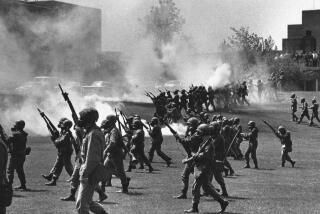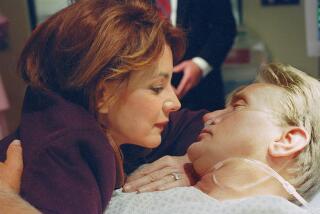War Is Hell, but ‘Civil War’ Is Splendid : Television: On Sunday, PBS fires the first salvo of its 11-hour miniseries, a scintillating masterpiece not to be missed.
Southern novelist Robert Penn Warren tells us in “All the Kings Men” that no one is truly innocent, that even high-minded actions can result in evil.
Probably no television program in recent times echoes this more than “The Civil War” on PBS. Ken Burns’ 11-hour account of the War Between the States is an ironic masterpiece. It’s as scintillating and utterly seductive as television gets, a Yankee Doodle Dandy of a historical extravanganza from a man who combines a scholar’s appreciation of fact with a filmmaker’s eye and sensibility.
The miniseries will be broadcast Sunday through Thursday at 8 p.m. on Channels 28, 15 and 24, and at 9 p.m. on Channel 50.
If quality triumphs, “The Civil War” will march through five nights of prime time the way William Tecumseh Sherman marched to the sea, leveling everything in its path. It is that good.
“The Civil War” is a chronological narrative that unfurls simply yet creatively and artfully. There are sound effects, but only one major re-creation: Unseen actors read lines from the comedy that Abraham Lincoln was watching at Ford’s Theater when he was mortally wounded by John Wilkes Booth. As laughter in the theater swells, a gunshot.
Otherwise, history springs to vibrant life here from thousands of photographs--armies of photographers followed the Union and Confederate armies--enhanced by approximately 900 first-person quotes from war letters, diaries and memoirs. The unseen readers range from Sam Waterston as Lincoln to Jason Robards as Ulysses S. Grant, from Julie Harris as Mary Chestnut to Morgan Freeman as Frederick Douglass, from Jody Powell as Stonewall Jackson to Studs Terkel as Benjamin F. Butler.
Although drawing from numerous consultants for his research, Burns disdains talking heads and uses only a few authorities as on-camera commentators, principally historian Shelby Foote, whose soft Southernese becomes almost a secondary narration.
There is no finer historical documentary maker in America than Burns, whose previous topics have included the Brooklyn Bridge and the Statue of Liberty. Consider his task here: Create a living history on the screen without having footage of that history.
Fortunately, his great genius as a visual storyteller is his ability to draw fluidity from stillness. His camera pans charred, swollen bodies as if it were Lincoln’s own eyes wearily surveying the battlefield. Sometimes the camera seems to come almost from within the old photographs that Burns is shooting, starting at the center and then ever-so-slowly pulling back, or vice versa, creating a sense of motion. All the while, bugles or drums or cannon or horse hoofs or shouts or moans or readings or music come across the sound track.
The sights and sounds are beautifully mixed. Jay Ungar’s mournful “Ashokan Farewell” interweaves the entire production, and “Jacob’s Ladder,” “The Battle Hymn of the Republic” and other songs, since passed down like genes from generation to generation, set moods and tones.
Burns presents the war from infinite perspectives--the personal stories of both major and minor figures, the famous and the anonymous becoming the strands of a richly detailed historical tapestry. Hardly an aspect of the conflict, no matter how small, goes unmentioned.
Threading all of these diverse elements, meanwhile, is David McCullough’s narration, a hint of poignancy in his flat, Everyman’s voice.
If “The Civil War” has a serious flaw, it’s Burns’ failure at times to see enough of the past in the present.
The point is made--through the words of Douglass and others--that the Emancipation Proclamation freed blacks from slavery, but not from discrimination, a condition that continued to prevail during the South’s ensuing white supremacy years and that remains a sore that festers nationwide today.
In other ways, however, historical links to the present are unexplored. For Foote to almost cavalierly dismiss Sherman as “the first modern general” because of the way his Union troops waged ruthless war on innocent Confederate civilians while marching southward, for example, suggests tacit approval of acts as indefensible as the My Lai massacre in Vietnam.
The Civil War had its own massacres. In the first installment Sunday, Burns sets the stage for Southern secession and war.
By the late 1850s, the United States resembled a giant picture puzzle whose pieces were loosening and falling away. McCullough: “By 1860, the last year of peace, one out of seven Americans belonged to another American.” As the nation’s “sleeping serpent” of slavery finally uncoils, war clouds thicken and hover ominously.
On April 12, 1861, Southern artillery fires on Northern troops inside Ft. Sumter off the coast of South Carolina, officially beginning the war that Foote says defined America like no other event in its history.
Like all wars, this one produced its own brand of nervous humor, and Burns spreads it liberally. A Confederate soldier observes about reticent Union commander Gen. George McClellan at Sharpsburg: “McClellan had brought superior forces . . . but he had also brought himself.”
One is especially struck by the initial fervor on both sides--entire towns signing up, and Army companies, in a forerunner of contemporary gangs, brashly calling themselves “Thrashers” or “Desperadoes” or “Killers”--and how this seems a metaphor for all war.
Yet jubilance here is eclipsed by death, as weapons exceed tactics and the bravery of soldiers often exceeds the ability of their officers to lead them. As a result, the carnage is appalling.
In this bloody universe, the air is thick with cannon balls, and soldiers crouch behind walls of their own dead. And from the diary of someone recalling the Battle of Shiloh in 1862: “Everywhere wounded men lay in agony. Neither army had yet devised a system for gathering or caring for them on the field. Scores of wounded collapsed and died drinking from a mud hole near the peach orchard, staining the water red. It began to rain, and flashes of lightening showed hogs feeding on the ungathered dead.”
Even more indelible are the photos:
* Amputated limbs stacked like firewood.
* Rigid, twisted bodies, their “fixed eyes staring at the sky.”
* Three eyeless skulls resting together on the earth, neither who they once were nor whose side they fought on mattering any longer.
* The infamous Confederate prison near Andersonville, Ga., its skeletal inmates appearing too weak even to move.
The moment of the entire series, though, is a sequence depicting the pivotal 1863 defeat of Robert E. Lee’s Confederate army at Gettysburg--the battle was a war in itself--that cost both sides dearly. It ends with Waterston reading Lincoln’s famed Gettysburg address as photographs of battlefield dead dissolve to ancient newsreel footage of white-haired Gettysburg veterans many years later revisiting this place where their comrades fell.
Finally, there’s Lincoln’s assassination as a grim postscript to four years of war that have just ended. The dying President is moved from Ford’s to a boarding house across the street, where he sinks like the sun, a brightness suddenly gone.
It’s one more memory that you take away from these 11 hours and another reason why, more than just a program, “The Civil War” is an event.
More to Read
The complete guide to home viewing
Get Screen Gab for everything about the TV shows and streaming movies everyone’s talking about.
You may occasionally receive promotional content from the Los Angeles Times.






